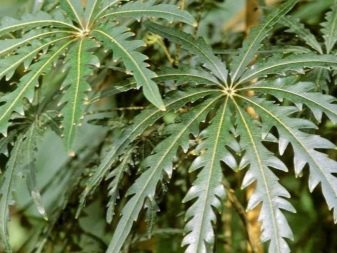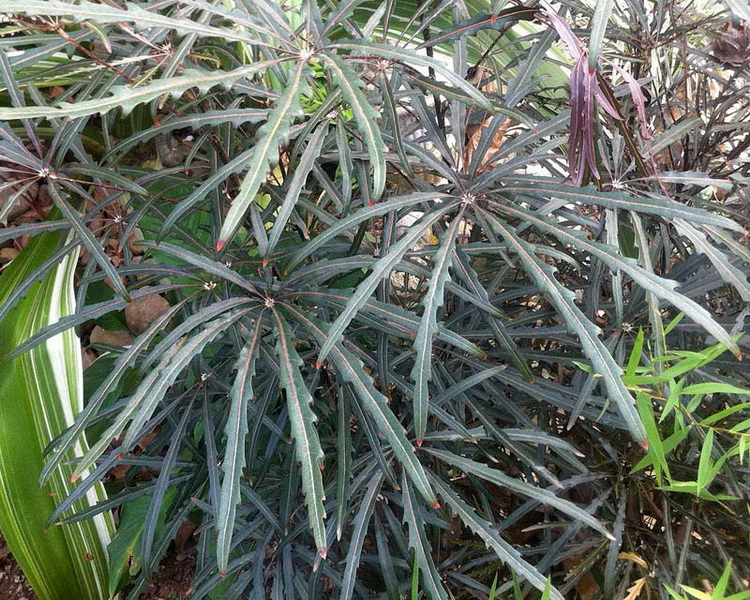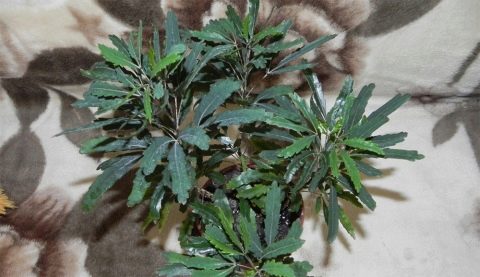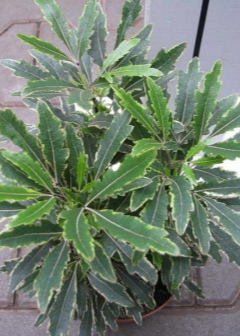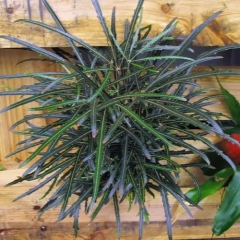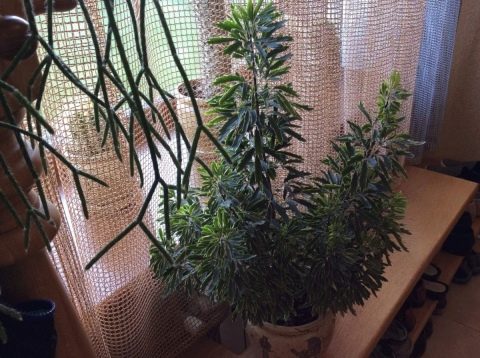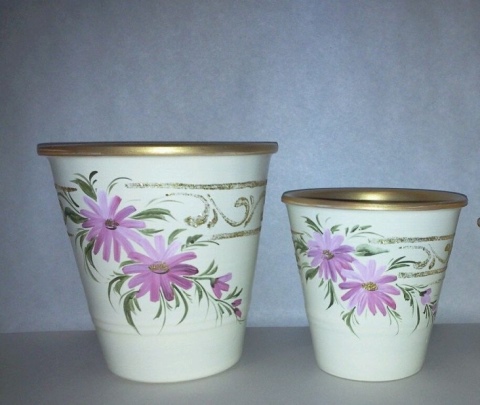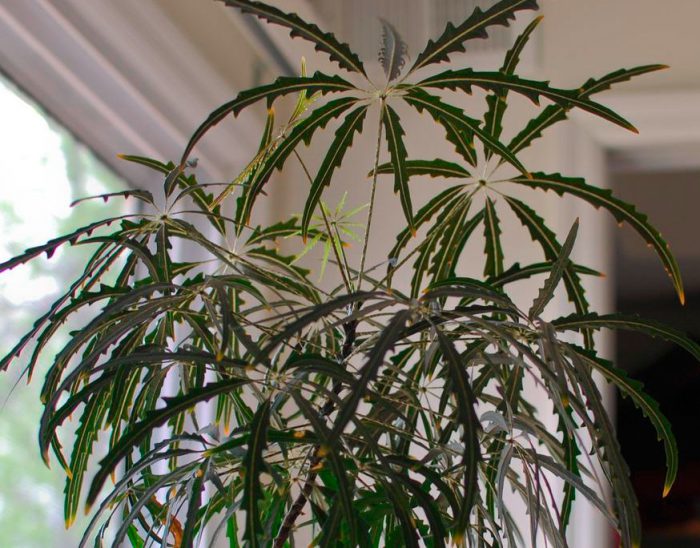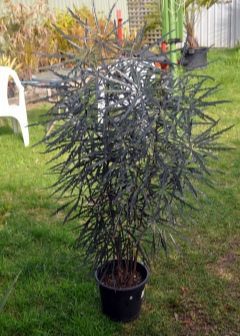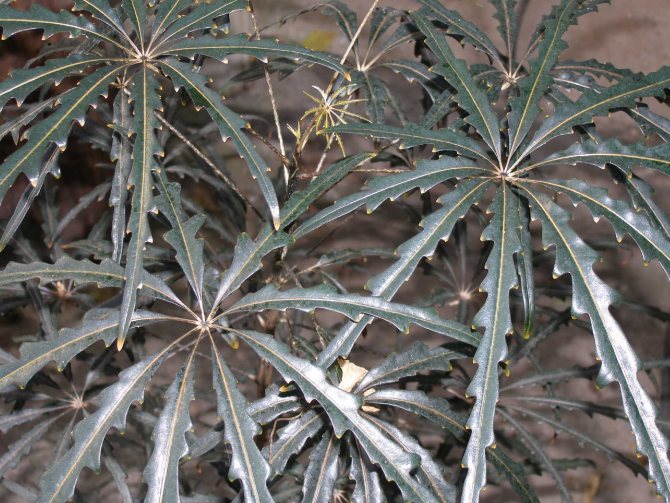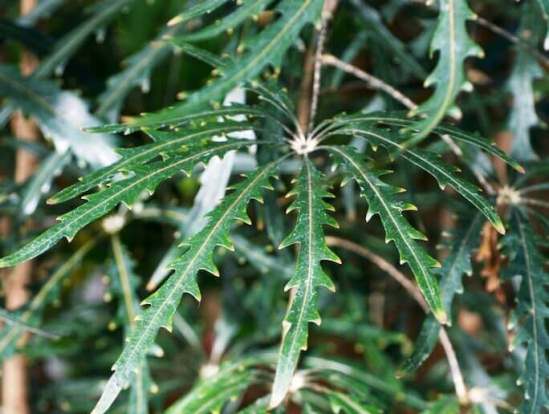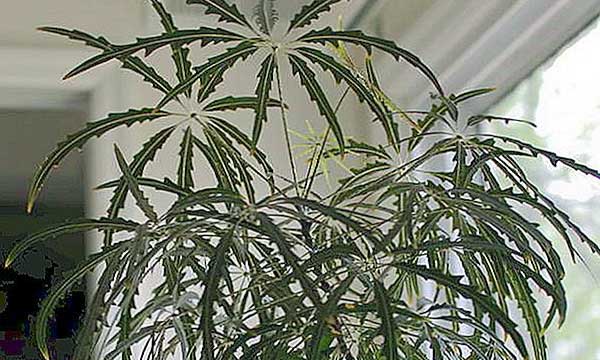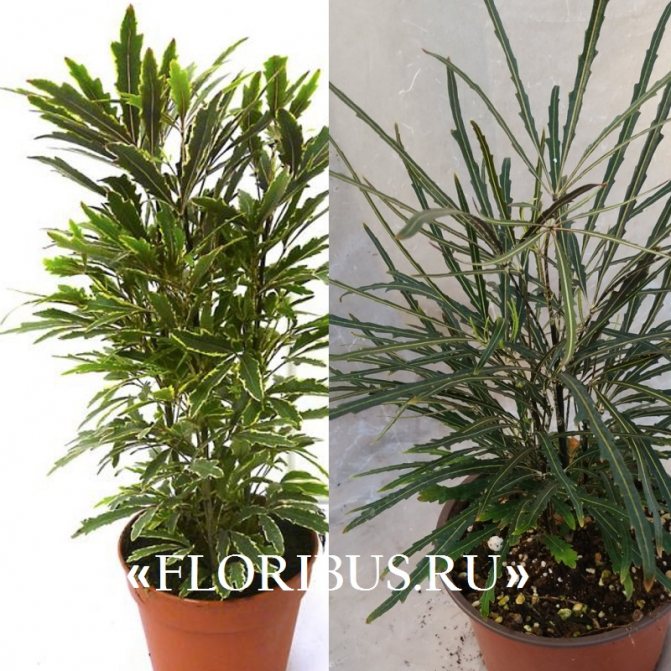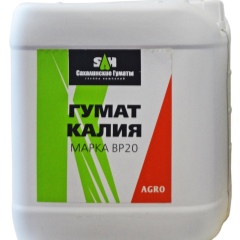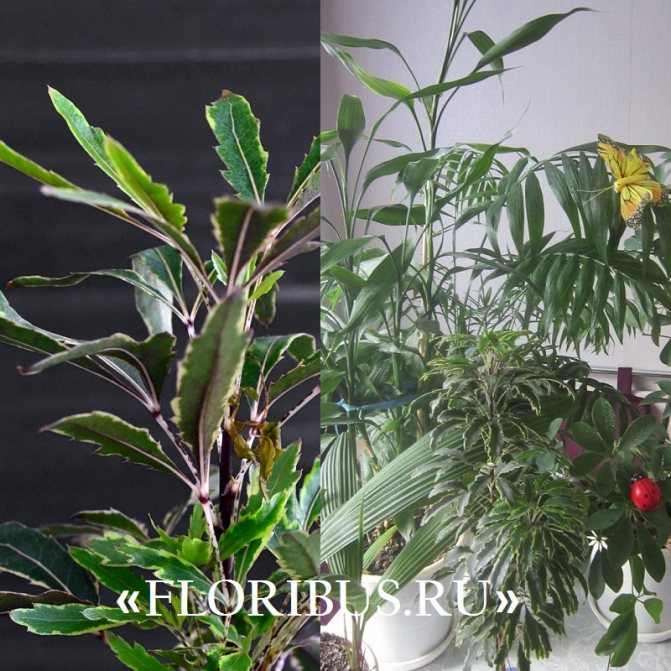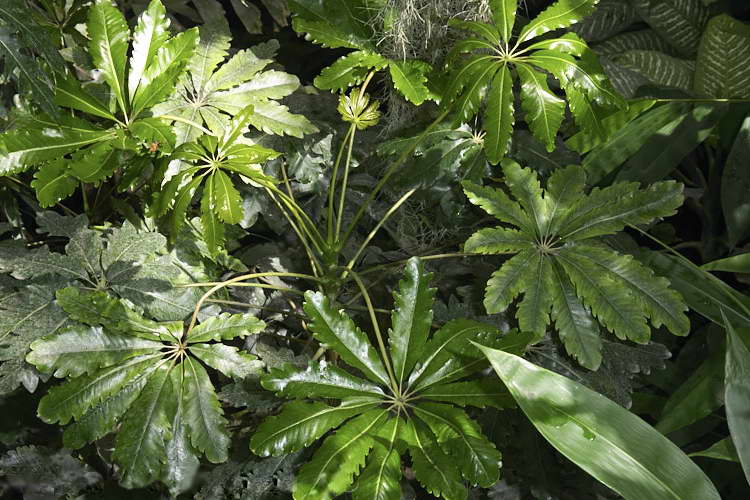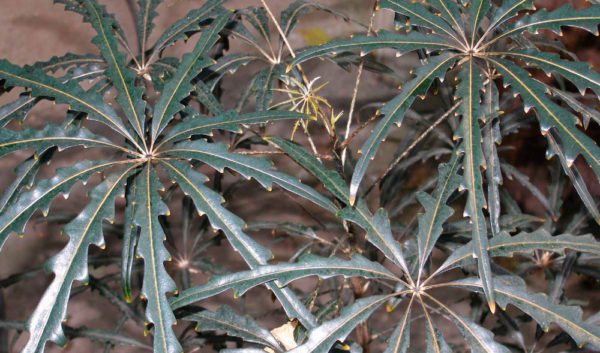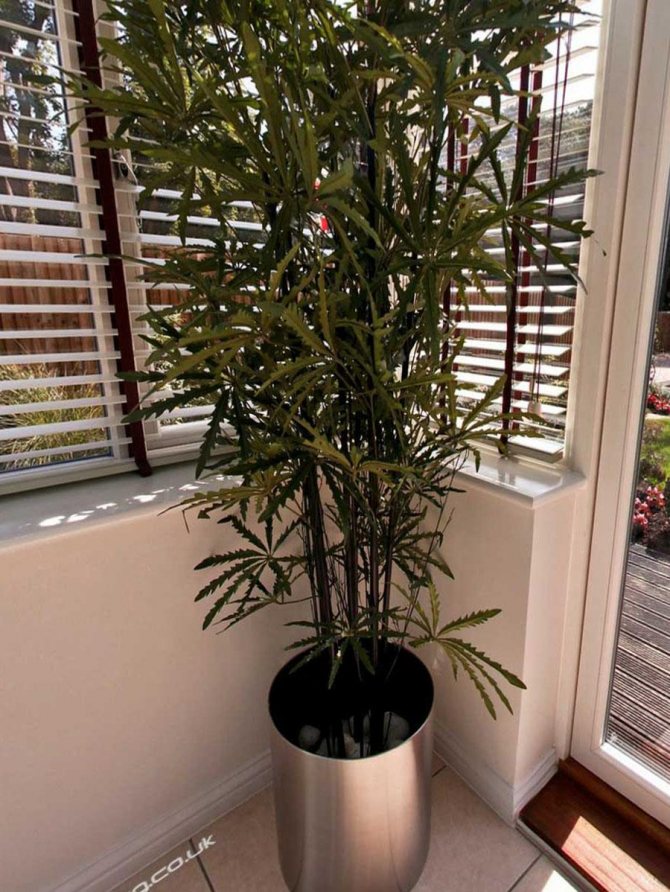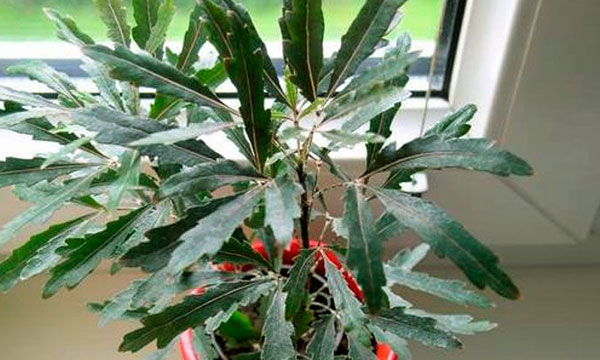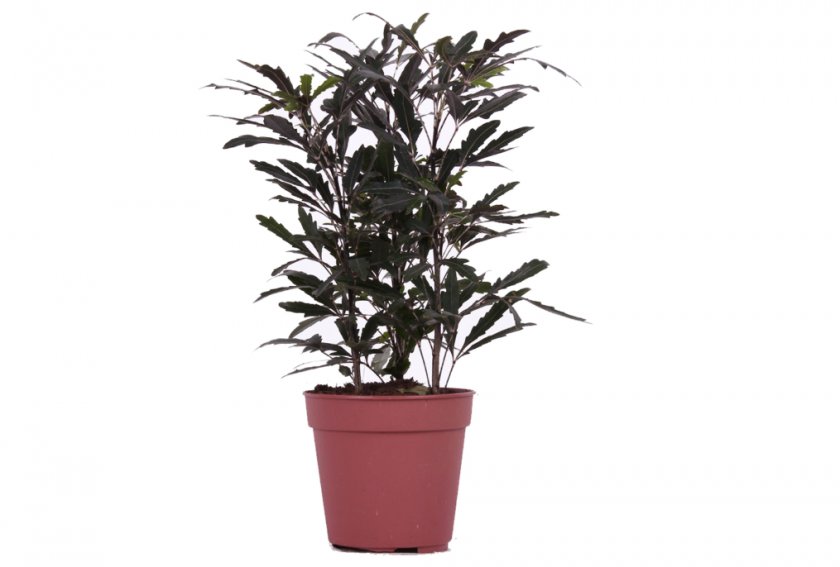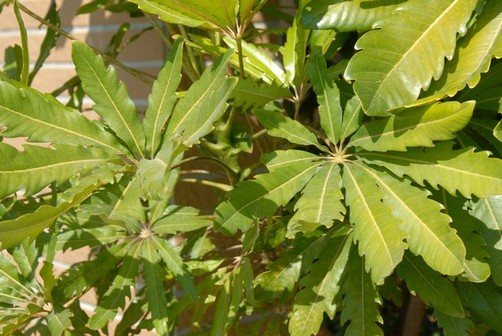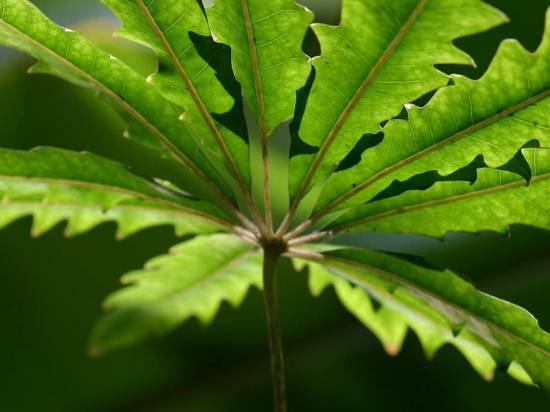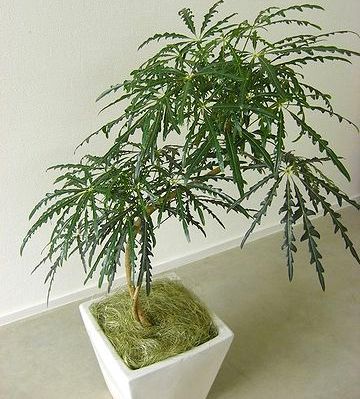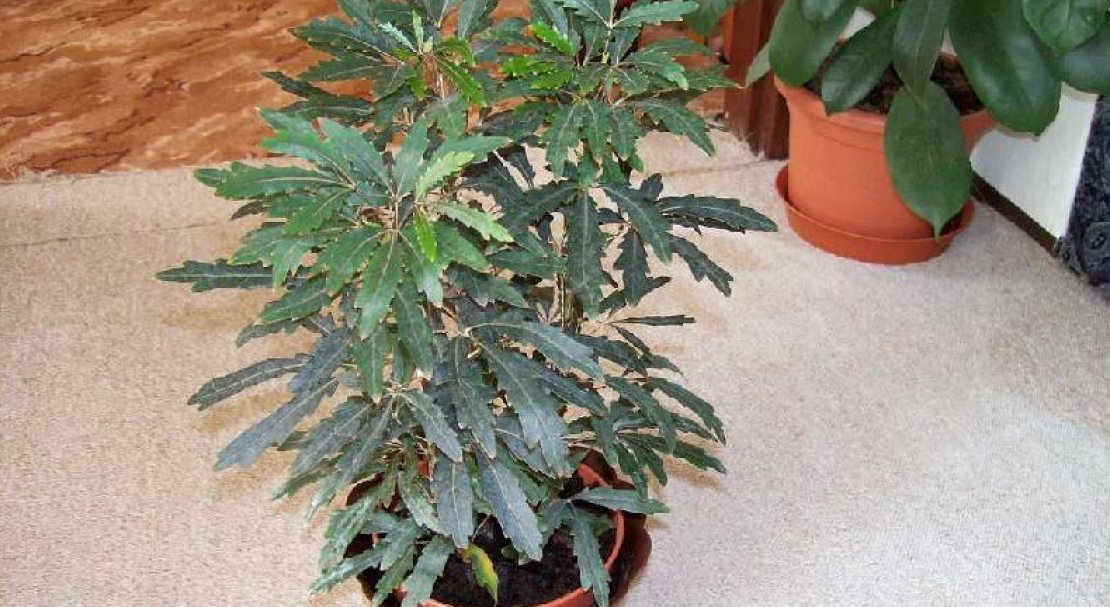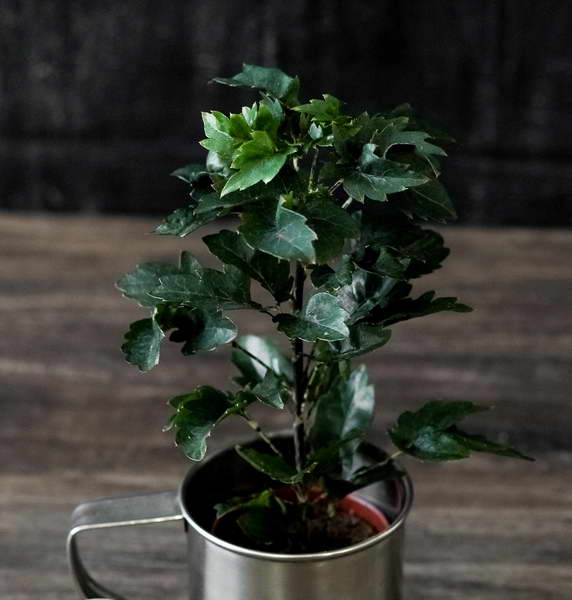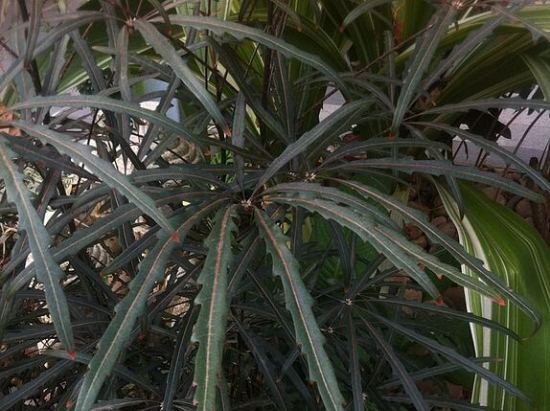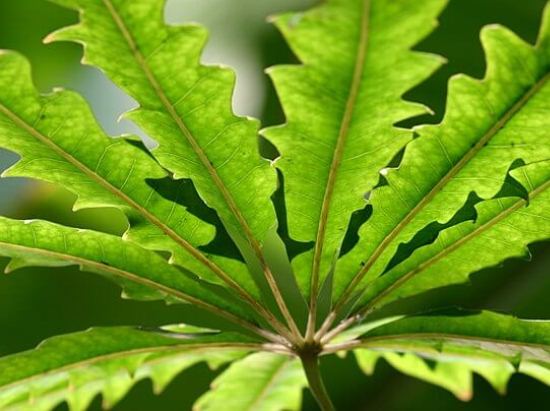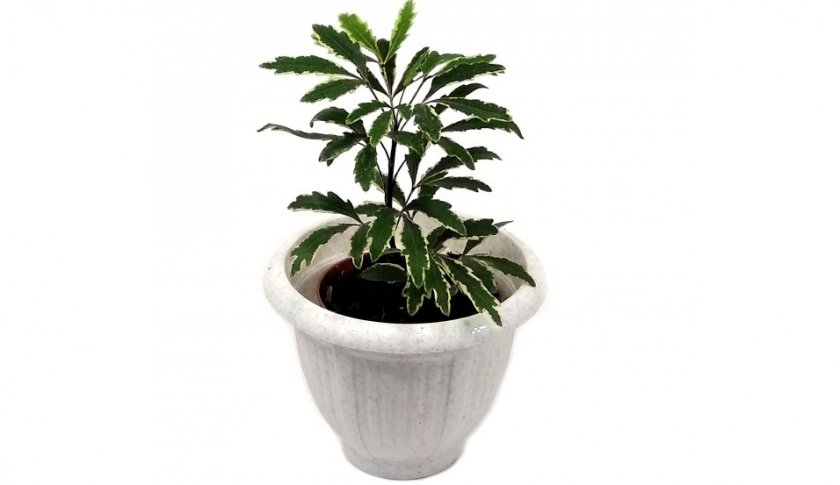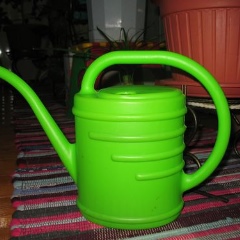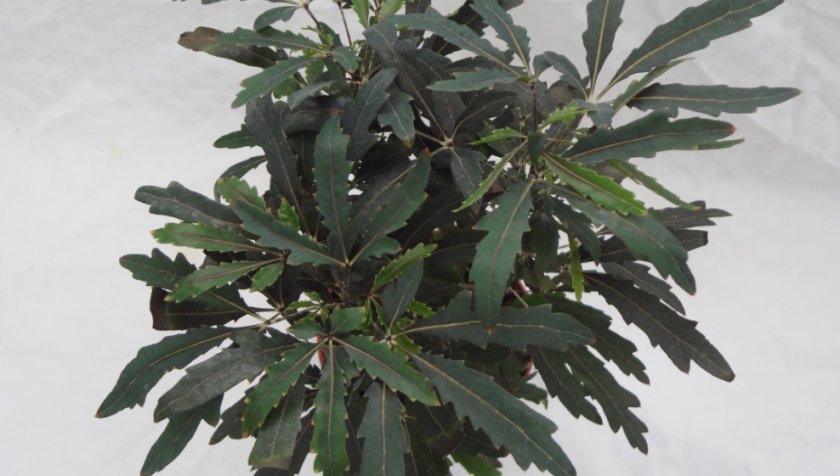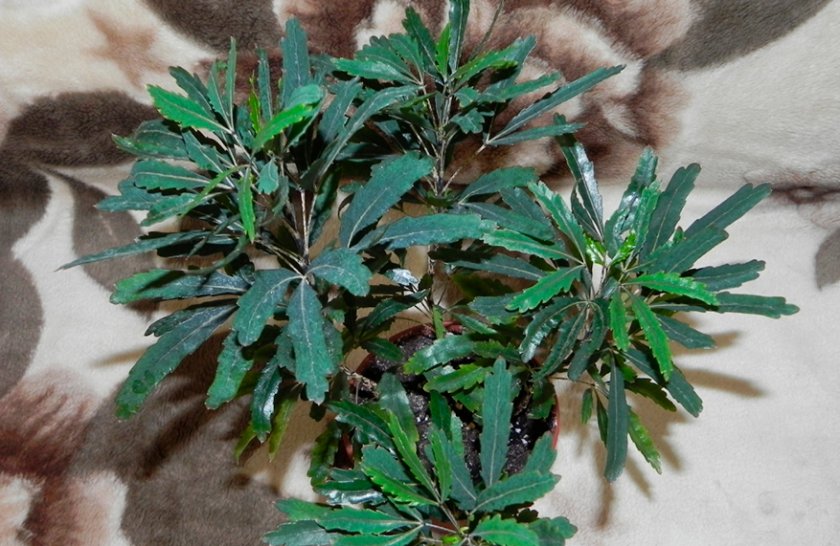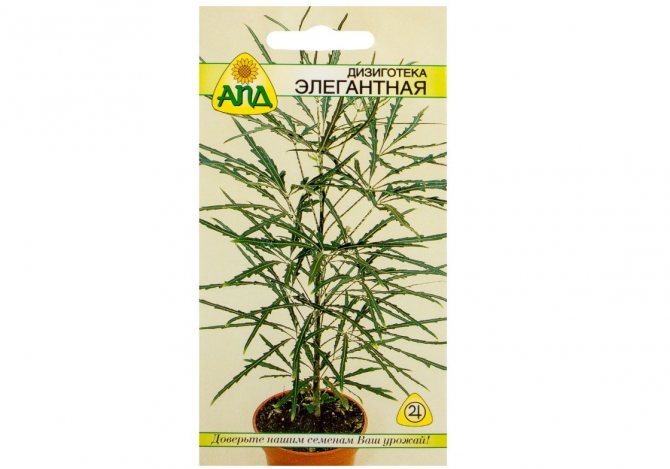How to care for a dizygoteka
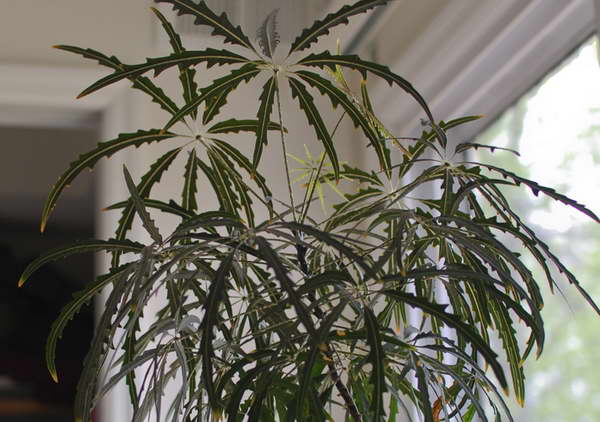
Dizigoteka elegant home care flower photo
The natural habitat of the plant is tropical forests; the place prefers in the shade of taller trees. For a tree to grow beautifully, indoor growing conditions must correspond to natural conditions. In caring for a dizygotek, it is necessary to strictly follow all parameters: the degree of lighting, watering, air humidity.
Lighting
The most suitable place in the house would be the eastern side of the room: there is enough light, there are no scorching midday rays of the sun. The north side will definitely suffer from a lack of lighting. The southern and western sides will harm a large amount of bright lighting, from which the dizygoteka will begin to shed foliage, and in the future this will lead to the death of the entire plant.
It is important to maintain a constant position of the tree relative to the light source: you cannot turn or move, otherwise it will also provoke a drop of foliage. In winter, it is necessary to provide daylight hours with a length of 10-12 hours
Use artificial lighting with phyto lamps or fluorescent lamps.
Air temperature and ventilation
Keep the air temperature in the range of 18-29 ° C throughout the year. A decrease in air temperature to 16 ° C is fraught with leaf shedding.
The plant does not tolerate drafts and sudden temperature changes, but loves fresh air. Due to its size, it is problematic to take out the tree every time to fresh air, so ventilate the room more often, but make sure that the dizigoteka does not get caught in the air stream.
Humidity of air and spraying
As a resident of the tropics, dizigoteka requires high humidity (at least 60%). Spray the plant several times a day in summer and especially in winter, as the air is dry due to the operation of heating systems. In winter, additionally put on a pallet with damp pebbles, moss, bathe under a warm shower.
Watering
Watering needs balanced. Water abundantly, regularly in the spring and summer, and in moderation in the winter. Remember that with insufficient watering, the leaves will begin to dry out, and excess moisture will lead to acidification of the soil and the development of diseases. Between watering procedures, the top layer of the soil should dry out - always focus on this parameter.
For spraying and watering, use soft, well-settled water at room temperature.
Priming
An important criterion is soil fertility. The plant is suitable for both neutral soils and with a slightly acidic or slightly alkaline reaction. You can use a ready-made substrate for dracaena or indoor ornamental deciduous plants (to increase the "lightness" of the soil, add vermiculite or coarse river sand). If possible, prepare the soil mixture yourself: mix 1 part of humus, sand and 2 parts of turf soil.
Top dressing
During the period of active growth (spring-summer), it is necessary to feed the plant. Do this every two weeks. Use liquid compound fertilizers. You can apply them under the root and by spraying - the moisture-loving dizygotek will like it.
Pruning and shaping the crown
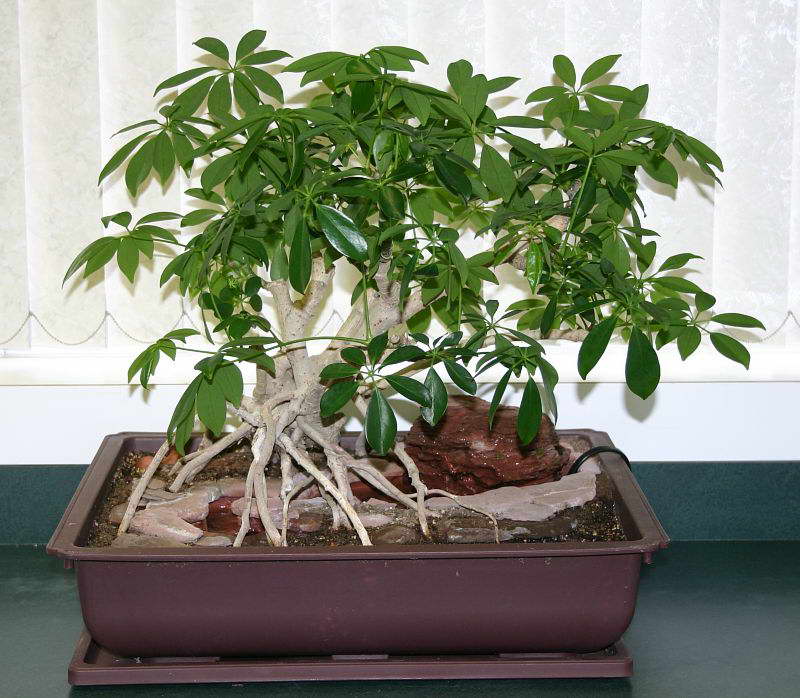
Bonsai from the dizigoteka photo
To form a neat crown, it is necessary to prune. If everything is left to chance, as the dizigoteka grows, it will constantly shed the lower leaves (which is a natural process), and the result will be a bare trunk with leaves only at the top. Pinching the tops will not work. It is necessary to drastically cut the plant in early spring. Leave literally a stump 15 cm high from the soil level.The dormant buds will begin to wake up, new shoots will appear, extending from the base of the trunk.
Diseases and pests
The tropical palm is exposed to such diseases and pest attacks:
shedding leaves
- this is due to drafts or too dry indoor air. It is necessary to monitor the optimal conditions for keeping the plant;
- insect pest of transparent color, destroyed only by insectoacaricide preparations: they need to be sprayed not only with leaves and twigs of a dizigoteca, but also introduced into the soil;
- a small insect that feeds on plant sap, destroys the leaves, forms a sticky coating on them. It can also be destroyed by non-toxic oil-based preparations - such a tool must be sprayed evenly over the entire surface of the leaves until a transparent film forms on them. Avoid getting the drug on the flowers - they will quickly stick together and may wither. If the lesion by aphids is not massive, you can simply cut off the damaged leaves and regularly spray the plant with water, washing away the eggs of the aphids;
scabbard
- a small insect with a small waxy shell. Sucking out the juice of the dizigoteca, the scabbard damages the leaves, the plant quickly withers and sheds damaged leaves. If measures are not taken in time, the dizigoteka is doomed to death. To destroy the scabbard, it is necessary to treat the affected leaves with a weak soapy solution, and then spray them with an insecticide. After treatment with the drug, the plant must also be treated with soapy water (you can use a soft brush for gentle cleaning). In case of severe damage by this pest, the plant is sprayed with the drug and covered with a bag for 30 minutes - this will kill up to 95% of the scale insects. However, this method is permissible only in extreme cases - such a greenhouse effect will negatively affect the state of the leaves, and the plant can significantly weaken.
Despite the fact that caring for a dizygotek is not easy, the effort will be justified: this tropical palm has a very effective decorative look. Having got such a beauty at home, you will never be able to part with her.
In the wild, the dizigoteca grows in Australia and on the islands of the ocean. It is not a tall evergreen ornamental shrub with split, toothed leaves. They are colored copper-red, sometimes almost black. Caring for a dizygotek at home requires some effort: for example, it needs annual pruning to form a beautiful crown of a tree.
Houseplant dizigoteka
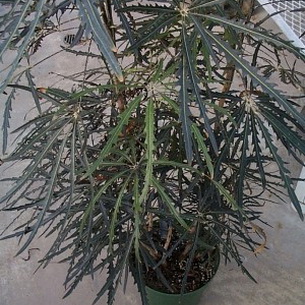
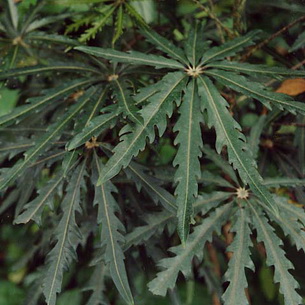
Family: Araliaceae.

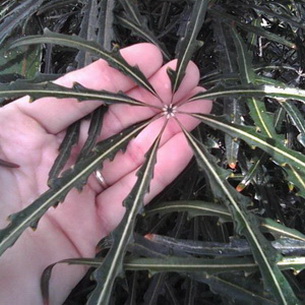
Rod Dizigoteka - Dizygotheca
Homeland: New Caledonia archipelago in the Pacific Ocean.
The genus includes 17 species of evergreen shrubs and small trees common in New Caledonia and Polynesia. The most famous relative of the houseplant dizigoteka is ginseng. But if it is famous for its medicinal properties, then dizigoteca are grown for their beautiful leaves. It is a deciduous upright-stemmed plant, the decorative period of which lasts all year round.
Having met a plant called dizigoteka on sale, do not rush to pay a certain (most often very considerable) amount for it. The fact is that this graceful tree can create a number of intractable problems when keeping it in an ordinary apartment, especially if you do not have too much experience in the field of floriculture. And this is explained simply: the living conditions in an ordinary apartment differ from natural conditions, where an eternal, but not too hot summer reigns, it rains regularly and, most importantly, the air is constantly saturated with sea moisture.

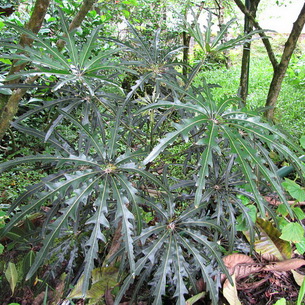
Botanical characteristics. In the natural environment, a dizigoteka is a tree up to 7–8 m high. Under indoor conditions, it is a small evergreen tree or shrub up to 1.5–1.8 m high. The leaves are narrow, palmate-compound, lanceolate, serrated, dark green, in young specimens a reddish strip stretches in the center.The flowers are small, inconspicuous, collected in umbrellas (in indoor conditions, flowering rarely occurs).
Look at the dizygotek in the photo, which shows different types of crops for street and indoor breeding:

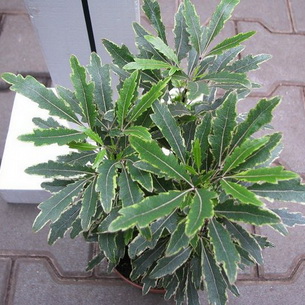

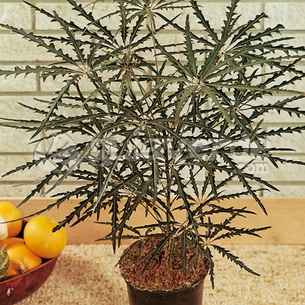
Conditions for the cultivation of indoor culture dizygoteka
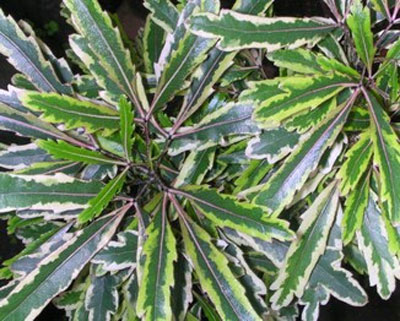
-
Lighting
... Dizygoteka develops well under the influence of bright diffused sunlight. It is best placed on windows with west, east, or in extreme cases, north orientation. One should not think that the direct rays of the daylight are terrible for the exotic. However, in order to avoid burns, it is recommended to shade the plant from the sun, especially in the summer. In winter, it will not be superfluous to provide additional lighting for the development of culture. In the summer, you can take a pot of exotic to the street, putting it in partial shade. -
Temperature regime
... During the growing season in a dizygotek room, the air temperature should be maintained at 20 ° or slightly higher. In the cold season, the thermometer should not drop below 15º, the optimal thermal regime is 16-18º. It is necessary to protect the dizygotek from drafts and not place it next to the batteries. -
Air humidity
... An evergreen shrub needs high air humidity. Therefore, it must be sprayed, especially in summer. To moisten the leaves and shoots, use settled, soft water at room temperature. An alternative to manipulating the spray gun is to place the flower pot in a tray filled with moistened expanded clay.
Capacity and soil for planting
... The plant is planted in a medium-sized pot. The soil is used light, loose. Its composition can be as follows: 2 hours of sod land, 1 hour of humus and 1 hour of sand. A high-quality drainage layer is placed on the bottom of the container.
Caring for dizygoteka elegantissima and other types at home
It is known that in nature, dizygoteka is found in tropical forests, where the air humidity is increased and it is warm all year round. It is quite logical to assume that at home care for the dizygoteka should be organized in such a way as to recreate the environmental conditions as much as possible.
Dizygoteka needs high air humidity, so it is useful to regularly spray the plant with warm, settled, and preferably boiled or distilled water. If you pour it with tap water, then unpleasant stains will remain on the leaves. It is especially necessary to approach irrigation carefully during the period when the central heating is turned on.

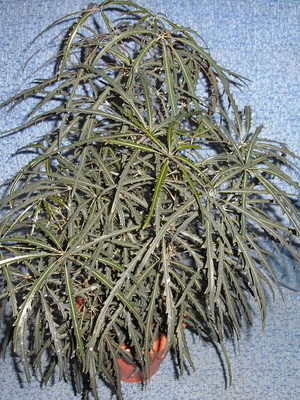
Dizigoteka is a graceful plant, which is highly undesirable for sudden changes in temperature. In order for it to delight all households and guests with its shoots, a constant moderate temperature is recommended - in the range of 15-23 ° C.

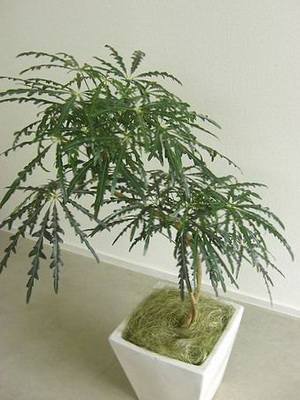
The plant requires not only a bright room, but also protection from direct sunlight, especially in the summer. The leaves will wither quickly under the scorching sun. It is better to place the dizygotek on the windows of the east or west exposure. If the flowerpot will stand on the southern windowsill, then you should use different shading devices.
During the active growing season, the plant needs moderate watering with soft water at room temperature. The following photo shows how to take care of the dizygoteka at home:

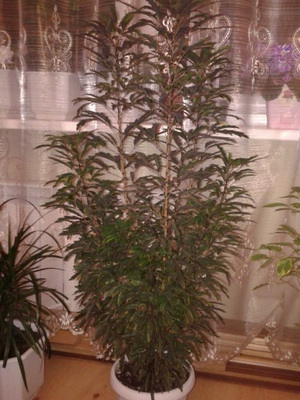
For planting, an ordinary flower substrate or a mixture of turf and leafy soil and sand (1: 0.5: 1) is suitable. But it must be remembered that the plant needs constant feeding, since the soil in tropical countries is significantly different from that in which domestic housewives plant the dizygotek.
The plant is fed with liquid fertilizers suitable for decorative leafy representatives of the flora, once every two weeks in the warm season. The following photo shows that with proper care of the dizygotek, it is necessary to dilute the fertilizer in half the concentration:
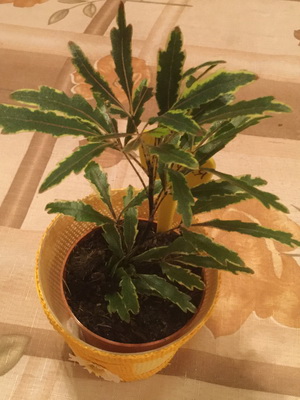
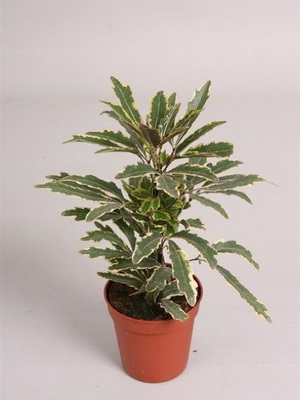
Otherwise, there is a high probability that the roots will be damaged.
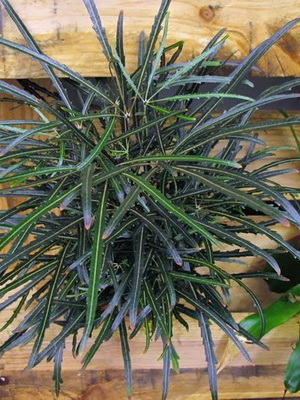

When purchasing a dizigoteka in a store, you need to understand that it is reluctant to bush. If there is a branchy plant on the counter, then most likely it is several seedlings in one pot.
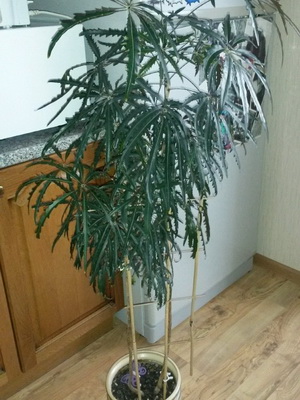

When caring for dizygoteka elegantissim at home, you need to know that in order to achieve branching shoots, it will be necessary to prune it from time to time. Side branches will only be formed by cutting the crown.
Those shoots that go to the middle of the crown should also be removed.
If the dizygoteka doesn't like something - the air in the room is too dry, hot or cold, a draft - then it instantly sheds its leaves. As soon as the leaves begin to fall off, it is necessary to immediately look for the cause of poor health and eliminate it.
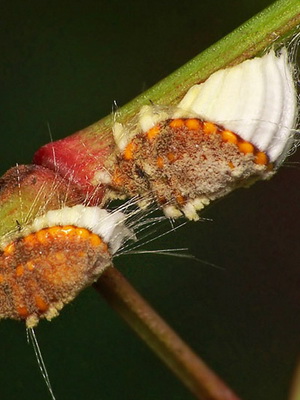
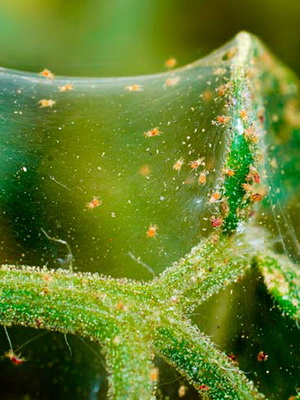
Among the pests that infect the roots and shoots, the scale insect and spider mite are distinguished. The plant must be sprayed with a special pest-fighting agent. In this case, it is necessary to cover the ground with polyethylene to avoid the ingress of toxic substances into the roots.
Main types
The dizigoteka plant is represented by different varieties. Each of them has its own characteristics. In nature, there are more than 100 species, but only some of them are adapted to domestic conditions.

Under the right conditions, a tree can grow up to 150 cm
Dizigoteca elegantissima
The most common type. Differs in complex serrate leaves, which are located on long petioles. On one branch there are up to 11 leaves of an elongated narrow shape. They have serrated edges.
It blooms rarely, the inflorescences are collected in umbrellas, which are white in color. They look inconspicuous and unobtrusive.
Dizigoteka Bianca
The leaves are dark green with purple veins. Irregular cream-colored edging trims the edges. All this gives the plant a variegated appearance. The leaf blade rarely exceeds 9 cm in length and 1.5 cm in width. The edges are serrated with slightly smoothed apices.
Dizigoteka graceful
Grows up to 2 m in height. Leaves are long, narrow, collected in umbrellas of 11 pcs. It branches poorly, usually most of the leaves are at the top of the tree.
Other species and varieties
Dizygoteka Castor is distinguished by a yellowishwhite streaks on the leaves... They consist of three segments and rarely exceed 9 cm in length.
The Zhemani variety is distinguished by wide leaves up to 3-4 cm, and the plates reach up to 5 cm in length. The central vein is reddish, the teeth are of the same shade.
Dizigoteka Veyche is distinguished by smooth edges of leaves, which grow up to 4 cm wide. The description of the Kerkhova variety does not differ from Veyche, only this species has a paler color.
Reproduction
Dizigoteca propagation occurs in two ways - by cuttings and seeds.
Cuttings
You can use those cuttings that are left over from spring pruning.
For correct reproduction in this way, you must adhere to the following recommendations:
- The cuttings must be treated with drugs that stimulate the process of root formation ("Kornevin", succinic acid, etc.).
- Prepare the soil for transplanting - it should be a mixture of sand and peat in equal proportions.
- Plant the treated cuttings in moistened soil, cover with a jar or transparent bag on top (this will provide light diffusion), put under a lamp or provide good natural light.
- Ensure the optimum temperature - the soil must be warm, at least + 20 ° C.
- Regularly ventilate the pot of cuttings, do not forget to spray them.
- After small cuttings begin to take root, they must be kept at a temperature of + 18-21 ° C.
- When young shoots take root well and braid the ground with roots, you need to move them to another pot with a diameter of up to 10 cm and keep in a well-lit place with an air temperature of + 16-17 ° С.
This vegetative method is the most optimal at home.
This may be the result of improper adherence to the breeding process, a violation of the temperature regime, or even a disease or weakness of the plant itself.
Make sure that the roots of the cuttings do not rot or mold - for this, be sure to remove the film or jar that covered the plant.
If at the initial stages of transplantation, the temperature conditions approached the greenhouse or greenhouse, then as young shoots grow, it is necessary to carefully transfer them to everyday temperature conditions. The optimal time for reproduction of the dizygoteca in a vegetative way is the end of March (until mid-April).
The optimal time for reproduction of a dizygoteca in a vegetative way is the end of March (until mid-April).
Seeds
The least convenient and more troublesome way of breeding tropical dizigoteca:
The seeds are used by those that ripen in special seed pods. The breeding process in this way should take place at the end of winter.
The collected seeds of the dizigoteca are soaked for several hours in warm water, to which growth stimulants for deciduous plants are added.
Prepare the soil - it should be a mixture of peat and sand in equal proportions. The soil must be loose and light in consistency.
The planting process should take place at a temperature of at least + 27 ° C, therefore, an infrared lamp is used as an additional source of illumination.
Prepared seeds are introduced into the soil to a depth of 1-2 cm, be sure to moisten by spraying.
An important stage is the creation of greenhouse conditions: the seeds are covered with a film or glass jar and placed in a warm place (the temperature should be at least + 25 ° C)
It is important not to allow the soil to dry out - for this, the film or jar must be periodically removed and the soil must be sprayed again.
When the seeds germinate and at least 3 young leaves appear (about 2-3 months after sowing), they can already be transplanted into larger pots.
Dizygoteka: home care
Many novice gardeners like the elegantissima dizigoteca. Caring for a plant at home requires special conditions.
Important! The development of the dizogote depends on the competent content. Growing a tree will only be successful if you follow the recommendations.
Watering
The plant is watered every 3-4 days in summer. An earthen who needs to be allowed to dry out a little.

Stagnant moisture will lead to root rot
In winter, watering is reduced to 1-2 times a week. It is better to use settled or filtered water, as hard, chlorinated water will lead to problems.
Temperature
In the warm season, it is better to maintain the temperature at 23 ° C, an increase to 28 ° C is permissible.
Important! Sudden changes in temperature should not be allowed, as this will negatively affect the appearance of the plant. In winter, the temperature should not fall below 16 ° С
In winter, the temperature should not drop below 16 ° C.
Humidity
The homeland of the dizigoteka is tropical forests, so it needs a high level of humidity. For this plant at home every day they are sprayed with a spray bottle.
Additionally, you can put a tray with pebbles, which are poured every day with water, or containers with liquid
It is especially important to maintain a high level of humidity during the heating season.
Due to the dry air, the leaves of the dizigoteca will begin to fall off and dry out.
Pruning
Cut the stems once a year in mid-spring. This is necessary for the plant to have a lush crown. Dizygoteka refers to low-branched species, therefore, without artificial crown formation, it will look like a palm tree.
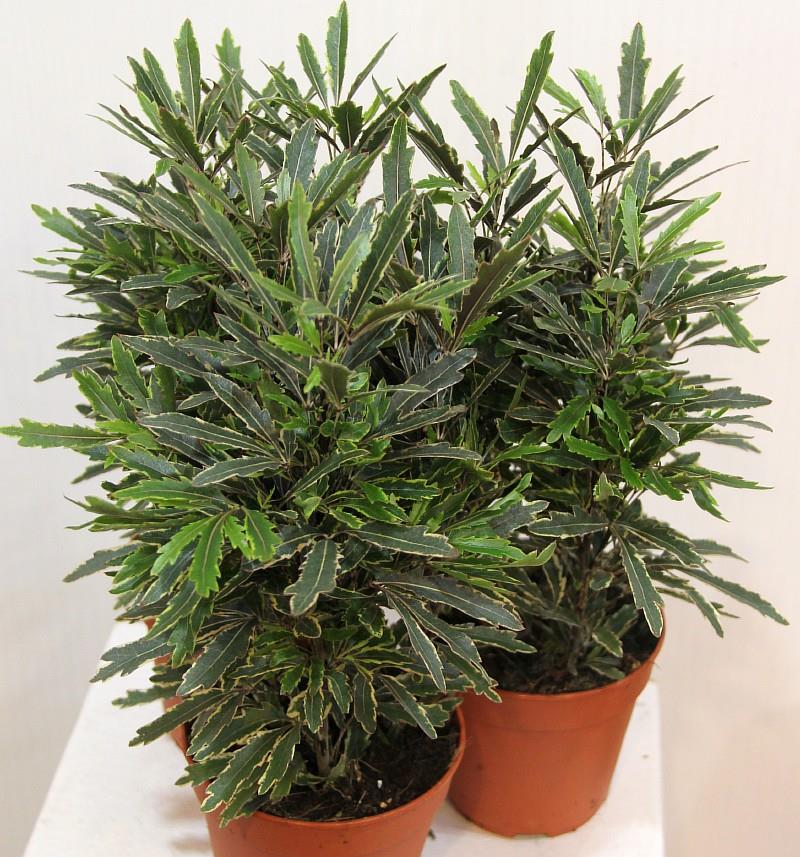
Without pruning, the plant will look like a straight stick with leaves.
The top is cut to 1/3 of the length, the next year they also come with side branches.
Lighting
Dizygoteka needs proper care. Any changes and deviations negatively affect her well-being.It is better to put the pot with the plant on the east window, on the north one will have to organize additional lighting with a lamp.
Dizygoteka needs bright diffused light, direct scorching sunlight will burn the leaves. But even in the shade, they will begin to fall. Both in summer and in winter, daylight hours should be 12 hours.
Important! The plant perceives artificial lighting well, so you can put a high-quality phytolamp. In the conditions of Russia, the dizygotek cannot be taken out into the street even in warm weather.
A slight drop in temperature or dry air will negatively affect the plant.
Fertilizer
Top dressing is applied during the period of active growth, that is, from May to October. This should be done every two weeks. To do this, use complex fertilizers for ornamental plants, organic or mineral.
It is important to dilute the drug according to the instructions. Only in this way the dizigoteka will not receive a chemical burn and will actively grow.
In the winter period, additional feeding is not applied.
Transfer
Dizygoteka grows very slowly, so young trees are transplanted every 2-3 years. Adult specimens can be left alone. It is enough to change the topsoil once a year.
Important! If the bush grows well, then it is better not to disturb it, since any stress will lead to death. The number of transplants depends on the age of the plant.
Each time the pot should be a maximum of 1.5 cm larger. As a soil, you can take a universal mixture or make it yourself. To do this, you need to take in equal parts humus, sand and 2 parts of the foliage of the earth. All components must be mixed. A layer of broken brick or expanded clay must be placed on the bottom of the pot
The number of transplants depends on the age of the plant. Each time the pot should be a maximum of 1.5 cm larger. As a soil, you can take a universal mixture or make it yourself. To do this, you need to take in equal parts humus, sand and 2 parts of the foliage of the earth. All components must be mixed. A layer of broken brick or expanded clay must be placed on the bottom of the pot.
The plant is transplanted by the transshipment method. To do this, it is carefully pulled out of the pot and placed in a new one in exactly the same form. There is no need to shake the earth from the roots.
Anyone can take care of the dizigoteka, but you should first familiarize yourself with the detailed recommendations.
Growing features
Location. Dizigoteka at home is very fond of a lot of light. She is able to transfer even the direct rays of the sun. But at the very solstice (at noon) it is best to protect the plant from the rays.
In winter, place the pot on a well-lit windowsill. This condition is especially true if the room temperature is more than eighteen degrees. In this case, you can make artificial lighting for the plant. In the summer, you can move the crop to fresh air.
Temperature
A comfortable temperature in the room should be twenty degrees. The culture is not very fond of the heat. In winter, the room temperature can be adjusted from fifteen to eighteen degrees. It is not necessary to place the container near batteries or other heaters.

Humidity
The flower is demanding on the humidity of the air. The indicator should be above the norm. For this, the plant is often sprayed with water. In winter, wet expanded clay can be placed in the pallet. With the help of heating systems, moisture will evaporate and increase the humidity in the house.
Watering. Water the crop in moderation. Stagnation of water and dryness of the earth must not be allowed. The liquid must be allowed to stand for several days before being used for watering. As soon as the cold weather begins in the fall, watering is reduced to a minimum. The most important thing during this period is not to allow the soil in the pot to dry out completely.
Fertilizer. Once every seven days in the summer, you need to fertilize the soil of the plant. For this, fertilizers are used for ornamental crops.
Transfer. Every year in the spring, the dizygotek is transplanted.Sometimes this procedure can be performed once every two years. The substrate should consist of turf, sand and humus. There must be a drainage layer at the bottom of the container.

Reproduction
Dizigoteca propagation occurs by seeds and cuttings.
Dizigoteca seeds usually begin to be planted and grown in the spring. Before starting the process, they are soaked in a growth stimulator. The planting depth of one seed should be equal to the length of two such seeds.
The temperature for growing should be in the range of twenty to twenty-four degrees. Water the plant with a spray bottle. The seed box is covered with foil for a greenhouse effect. Every day it is necessary to ventilate the culture.

It is also possible to propagate dizygotek by cuttings. For this, shoots are used. But they do not give roots well, so their ends need to be treated with a special stimulant. Pour peat and sand into the container.
A cutting is planted there for rooting. The location of the pot should be in a well-lit area. Cover the box with plastic wrap to create a greenhouse effect. In the future, caring for the plant is the same as for ordinary seedlings.
All work with the dizigoteka culture is carried out strictly with gloves. It contains harmful and toxic substances. Children and pets should not be allowed to the plant.
Growing problems
- Yellow leaves - lack of lighting;
- Brown spots on the plates - the sun's rays hit the leaves;
- The culture does not grow, the leaves are crushed - lack of nutrients in the soil;
- Falling leaves - poor conditions of detention: temperature, humidity.
Diseases and pests, possible difficulties in care
The plant is resistant to diseases, but such pests as aphids, mealybugs, whiteflies, spider mites may appear. As a preventive measure, moisten a cotton pad with soapy water and periodically wipe the leaves. If pests are found, first treat with chamomile infusion. As a last resort, resort to using insecticides.
Due to violations of the rules of care, the following situations are possible:
- Withered, drooping leaves indicate over-watering - balance it.
- If the leaves dry, there is not enough moisture (water more often), or the location of the plant is not suitable (most likely the lighting is very bright, you need to move the pot and lower the air temperature).
- Due to the lack of nutrients, the color of the leaves becomes pale, their size decreases - it may be time to change the soil or simply increase the amount of fertilizer. Fading of leaves is possible due to exposure to too bright lighting.
- If the leaves have darkened, wilted - the air temperature is low for the plant.
- When watering with hard water, white bloom may appear on the leaves.
Dizigoteka dries up what to do
If the care is correct, and the leaves continue to dry, urgently cut off the surviving shoots and root them, just check that there are no darkening and signs of disease on the cut. First, hold the cuttings in a phytosporin solution, and then plant them in clean soil, disinfect the pots. Destroy the remains of the plant, discard the soil, disinfect the pot.
If it's a pity to cuttings, try to cut off all diseased branches and water the ground with phytosporin, also treat the whole plant and quarantine, away from other flowers. Repeat the treatment in a week. It is also advisable to feed with potassium humate in order to strengthen the plant's immunity.
Views
This plant has the following varieties:
- an evergreen tree-like plant. Its second name is elegant aralia. It differs from ordinary dizigoteca by a relatively weak branching system of branches. The leaves are larger in size, do not have a pronounced jagged edge. It is this species that is most often found in home breeding.Such varieties as “Castor” (with short leaves collected in bunches of only 3 pieces), “Bianca” (with a purple vein and cream-colored edges of the leaves) and “Gemini” (leaves are oval) were bred from the elegant dizigoteca;
- differs in wider and shorter leaves, which are not serrated along the edge, but are wavy-shaped. The color of the leaves in this species ranges from light green to dark;
- similar parameters with Veitch's view, however, the leaves have a lighter color.
Diseases and pests
- Dizygotek is attacked by spider mites, scale insects and thrips.
- With a lack of light, especially in winter, the lower leaves may fall off.
- With sunburn, light spots form on the leaves, which gradually darken.
- With a lack of nutrition, the leaves decrease in size, and the plant grows more slowly.
- Falling leaves occurs at low temperatures, lack of moisture, with sudden changes in temperature. The nearby heating radiators and drafts also contribute to the fall of foliage.
Observing some rules for growing this plant, you can watch how it grows and pleases with its beauty, complementing the green decor in your home. Grow in yourself such an amazing plant as a dizigoteka: caring for it at home is not too burdensome, and you can choose the desired variety from the photo and description.
Dizygoteka (lat.Dizygotheca)
belongs to the Araliaceae family and has about 17 plant species. Dizigoteca are evergreen shrubs or small trees native to Polynesia or New Caledonia.
Basically, you can buy only 1 type - Dizygotheca elegantissima. It is better for novice flower growers not to start growing indoor plants with this species, because the plant is quite difficult to care for.
Types for home cultivation
Only one variety is used as a home culture - the elegant dizygotheca, or elegantissima (Dizygotheca elegantissima). She is more familiar to some under the name "shefflera" or "aralia". In nature, it grows in the form of a large tree tall up to 8 meters and crown up to 4 meters. In a confined space, growth is inhibited. Home dizigoteca elegantissima grows no higher than 2 meters.
Shoots grow straight up. The leaves are divided into 7-10 equal lobes. The length of each lobe reaches 30 cm, the width is 2 cm. The shape of the leaf is thyroid, rounded. Contrasting color - light veins on a dark background. The length of the common petiole is up to 40 cm. The color of the petioles is light with a grayish tinge. It blooms with pale green flowers in late summer or September. After the end of flowering, the fruits ripen - round berries of dark brown color.
On the basis of the species, breeders have developed interesting varieties with original color and leaf shape. The following varieties are most often found in flower collections.
- Dizigoteka Bianca. The leaves are divided into 3-5 lobes, variegated. The veins are light purple, the edge is white.
- Dizigoteka Gemini. Differs in ovoid leaf shape. Divided into 3-5 wide lobes with a coarsely serrated edge. The color is dark green.
- Dizigoteka Castor. The leaves are not large, consist of three short lobes up to one and a half centimeters wide. The edge is covered with rounded teeth. The color of the leaves is dark, yellow veins stand out against its background.
For reference! Dizygoteka is grown as an independent plant - it looks interesting and self-sufficient. To create interesting compositions, it is combined with other indoor cultures. The choice is due to natural features, plant compatibility. In wildlife, it often coexists with scindapsus, codiaum, cycas, cordilina.
Types of dizigotek
There are many types of plants in nature, but one is used for cultivation.

Elegantissima (graceful) - evergreen, with a weak branching system, grows like a tree with a straight trunk, which gradually hardens. Leaves are linear, with triangular edges.Their number is up to 11 pieces, located on a long petiole. Flowers are collected by an umbrella. Other varieties descended from it have different color and leaf size.
| Variety | Leaf features |
| Graceful variegated | Motley speckled. |
| Castor | The broader of the three short lobes, with rounded denticles and yellow veins. |
| Bianca | Dark up to five lobes, their veins are purple, cream border. |
| Gemini (Gemini) | With coarsely serrated edges of a burgundy hue, they have five wide oval-shaped lobes. |
| Gracillima | Wide wavy, dark green, without pronounced veins. Low-growing variety. |
| Veitch | Wide, short, wavy. |
| Kerkhova | Light shade. |

